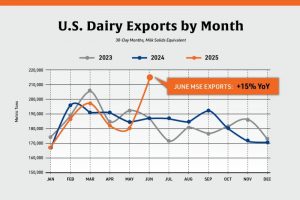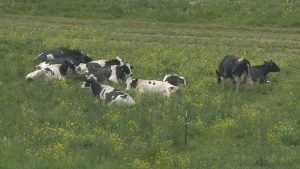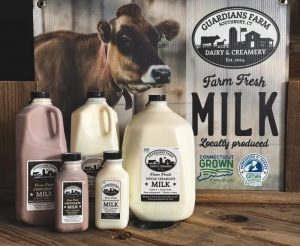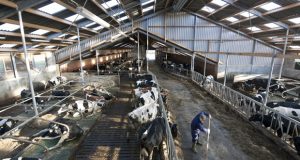
Ag Secretary Tom Vilsack discusses the Dairy Business Innovation Initiatives grant program at World Dairy Expo.
Dairy farmers have long expressed concerns over industry regulations and how supply vs. demand for milk impacts prices. Ag Secretary Tom Vilsack addressed some of those concerns Oct. 4 at World Dairy Expo in Madison, Wis., during the Global Dairy Summit, where he unveiled a program to help small and medium-size dairies boost farm income.
“The last four years have been excellent years for net farm income,” Vilsack said, “but not everyone feels that, which explains why 87% of U.S. farms have to rely on off-farm income. The answer isn’t necessarily just having more safety net. It is basically saying we have got to be smarter about how we can create profit from that farm.”
Creating on-farm profit
Vilsack said the top 13% of U.S. farms are doing fine, but the rest need a new, creative opportunity to boost farm income.
“Farmers should be paid to participate in programs through Climate Smart Agriculture initiatives,” he said.
Vilsack spoke about the federal push to help dairy farms generate income on the farm through more income streams, such as using manure digesters to turn manure into renewable natural gas, fertilizer and bedding for dairy cows, and getting paid for reducing carbon emissions on the farm.
Sustainable ag practices
At the heart of USDA’s mission is developing a model that allows farming operations under $500,000 in annual sales to thrive. Small and midsize farms are critical to rural communities — not only as economic entities but also as cultural and social pillars. As farms consolidate, rural communities face declining school enrollments, shrinking customer bases and reduced health care access. USDA is, therefore, exploring innovative approaches to ensure farm vitality, according to Vilsack.
Climate Smart Agriculture initiatives pay farmers not only for what they produce but also for their sustainable practices. Across the U.S., dairy farms are benefiting from 136 contracts that encourage climate smart practices and market premiums. Ecosystem service markets are emerging, promising additional income for environmental sustainability.
“You get better and stronger prices,” Vilsack said. “When you have that combination and then you create a local, regional food system that pays that farmer 50 cents of the food dollar or 75 cents of the food dollar, instead of 20 cents, then you’ve got a chance.”
A plan to help dairy
Vilsack pointed to $11.04 million in new funding that USDA is providing to farms and producers under the Dairy Business Innovation Initiatives grant program.
“USDA is committed to helping America’s dairy industry remain competitive as they work hard to provide necessary, nutritious dairy products to communities nationwide,” Vilsack said. “Through the Dairy Business Innovation Initiatives, we aim to help the dairy industry access new and better markets, spur innovation, and create economic growth. To date, the initiatives have invested over $64 million into more than 600 projects that are increasing dairy supply chain resiliency, creating new markets and expanding economic growth in rural economies.”
This year’s funds are being awarded to the four current DBI Initiatives at California State University, Fresno; the University of Tennessee; Vermont Agency of Agriculture, Food and Markets; and the University of Wisconsin. The initiatives will use the funding to provide valuable technical assistance and subaward funds to dairy farmers and businesses across their regions, supporting them with business plan development, marketing and branding, as well as increasing access to innovative production and processing techniques to support the development of value-added products.
This year’s DBI projects include:
Midwest. The Dairy Business Innovation Alliance in Wisconsin will use $3.45 million to continue to empower dairy farmers and processors in the Midwest with grant programs and technical assistance, focusing on expanding market opportunities and supporting value-added dairy product innovation.
Related:How to handle semen for top conception rates
Northeast. Vermont’s Dairy Business Innovation Center will use $3.45 million to extend its reach in the Northeast. As of August, this initiative has provided $31 million in support for 333 projects, ranging from farm modernization to energy efficiency improvements, all aimed at boosting resilience and efficiency across the region’s dairy sector.
Southeast. The University of Tennessee will use $3.45 million to support farmers across 12 states in the Southeast, enabling them to integrate innovative practices such as on-dairy innovation, product safety, farm sustainability and workforce development to improve financial outcomes and diversify the dairy supply chain.
West. In California, Oregon and Washington, the Pacific Coast Coalition will use $690,000 in new funding to continue revolutionizing the dairy sector by helping farmers tap into higher-value uses for milk, such as artisanal cheeses and organic dairy products. The coalition’s workforce training program will ensure dairy businesses remain competitive, allowing producers to diversify markets and income.
Dairy farmers and businesses interested in the program must contact the appropriate initiative to be considered for direct technical assistance or a subaward. For more information, visit the Agricultural Marketing Service Dairy Business Innovation Initiatives webpage.
You can now read the most important #news on #eDairyNews #Whatsapp channels!!!
🇺🇸 eDairy News INGLÊS: https://whatsapp.com/channel/0029VaKsjzGDTkJyIN6hcP1K























